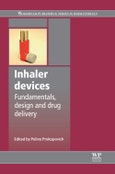Part one discusses the fundamentals and development of inhaler devices as well as drug formulations for inhalers. The treatment of asthma is also discussed. Part two reviews recent developments in drug formulation and nanotechnology for inhaler devices, emerging inhaler technology and possible future trends.
Inhaler devices: Fundamentals, design and drug delivery is an essential design guide for good industrial practice, and will be an invaluable resource for those researching and treating conditions such as asthma; and those developing and manufacturing inhalation devices.
- Introduces the fundamentals of inhaler technology- Discusses the history of inhalers as well as current research and development as well as possible future trends- Considers the development of inhaler devices, drug formulations and discusses the treatment of asthma
Please Note: This is an On Demand product, delivery may take up to 11 working days after payment has been received.
Table of Contents
Contributor contact details
Woodhead Publishing Series in Biomaterials
Preface
Part I: Fundamentals and considerations of inhaler devices
Chapter 1: Anatomy and pathophysiology of the respiratory system
Abstract:
1.1 Introduction
1.2 Functional anatomy
1.3 Pathophysiology
1.4 Analysis of pathophysiology
Chapter 2: History of inhaler devices
Abstract:
2.1 Introduction
2.2 Structure and function of the lungs
2.3 Inhalers and successful therapy
2.4 Nebulisers
2.5 Pressurised metered-dose inhalers (pMDIs)
2.6 Dry powder inhalers
2.7 Future trends
Chapter 3: Tribology of inhaler devices and components
Abstract:
3.1 Introduction
3.2 Design and principles of pressurised metereddose inhalers (pMDIs)
3.3 Friction and lubrication within inhaler devices
3.4 Measuring friction between pMDI components
Chapter 4: Novel coatings and biotechnology trends in inhaler devices
Abstract:
4.1 Introduction
4.2 Current trends in inhaler devices
4.3 Novel coatings
4.4 Biotechnology
Chapter 5: Microbial control and safety in inhalation devices
Abstract:
5.1 Microbial cells
5.2 Growth of microorganisms in the environment
5.3 Microbial inactivation
5.4 Microbial contamination control
5.5 Keeping inhalers microbiologically safe
Part II: Drug formulations for inhaler devices
Chapter 6: Chitosan and inhalers: a bioadhesive polymer for pulmonary drug delivery
Abstract:
6.1 Introduction
6.2 Chitosan-based inhaler drug delivery systems
6.3 The absorption enhancing effect of chitosan
6.4 Types of particle systems used in inhalers
6.5 Inhaler formulations based on chitosan and chitosan derivatives
6.6 Conclusions
Chapter 7: Polyelectrolyte assemblies for drug storage and delivery: multilayers, nanocapsules and multicapsules
Abstract:
7.1 Introduction
7.2 Layer-by-layer (LbL) multilayers for drug delivery applications: planar polyelectrolyte multilayers and capsules
7.3 Assembling of layer-by-layer multilayers
7.4 Variables affecting the electrostatic self-assembling
7.5 Properties of polyelectrolyte multilayers of interest in drug delivery
7.6 Encapsulation approximations
7.7 Encapsulating bioactive molecules
7.8 Strategies for releasing encapsulated drugs
7.9 Layer-by-layer capsules in drug delivery applications
7.10 Layer-by-layer capsules and inhalers
7.11 Conclusions
7.12 Acknowledgements
Chapter 8: Functionalized core-shell nanoparticles for medical applications
Abstract:
8.1 Introduction
8.2 New insights into copolymer-NSAID interactions
8.3 Materials and methods of interfacial and bulk studies of copolymer-drug aqueous systems
8.4 Experimental results and implications for intake and release mechanisms
8.5 Conclusions
8.6 Acknowledgements
Index








